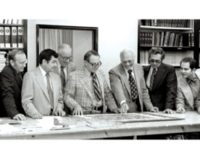Two engineers with Louis Berger Group Inc. who were ambushed on the Kabul-Kandahar highway in Afghanistan have spoken for the first time about how they cheated death while working on the most dangerous road construction project in the world.
 |
Roads Superintendent Fred Chace miraculously survived after being shot in the head while driving along the route.
He and fellow Roads Superintendent Mike Bois were working in a notorious stretch of the project between Kandahar and Qalat when their vehicle came under fire on Oct. 13.
Bois gave ENR an exclusive account of their terrifying ordeal, just before flying back to the U.S. this week for his first vacation since the attack.
"We were heading down to Section F and (the ambushers) had something set up to pick us off. When they are ready theres not a hell of a lot you can do," says Bois. "One guy comes out about 600 ft ahead of us, and he has a gun. Our shooters are in the vehicle behind us, so they go around us to try to cut this guy off. Fred was backing up at this point and I was telling him to just move away from the shooters as the car is fishtailing.
"At this point (an attacker) on the left hand side of the vehicle jumps out. He has a high caliber machine gun and he popped off two rounds. The window shattered and Fred went down. One bullet passed over me and one passed in front of me.
"Fred went down on the seat and I had a towel next to me, which I put on top of his head to stop the bleeding. "From that point the guy on the road ran off and the guy at the side of the vehicle was running toward the front of a building. It was 15 minutes before we got a van in and started to take Fred out and then we started taking fire again.
|
"Fred thought he was a goner and I thought he was a goner. There was blood all over the placeit was pumping, and when he moved the towel just a little bit, it shot out from the side. When it was all done, he said, You know something, I dont think it went through my head, because I can still think.' "
Chace and Bois have lived to tell the tale of their escape, but others working on the road have not been so fortunate.
Since construction started on this $250-million reconstruction project last year, it has been the target of a string of attacks mounted by suspected Taliban and Al Qaeda groups as well as local bandits.
Four security personnel were killed earlier this year and a Turkish engineer was kidnapped and is still being held, while ransom negotiations take place. According to a Nov. 18 news report in Al Jazeera, the engineer, Hassan Onal, is employed by Gulsan Cukurova, a subcontractor to Berger, and was captured Oct. 30. The kidnappers have demanded the release of six Taliban prisoners held in Ghazni province, and threaten to kill Onal if they are not freed.
Two weeks earlier, another Turkish engineer was shot in the hip while sitting in a vehicle, says Tom Nicastro, a Berger vice president based in Washington, D.C. Nicastro says that injury is more serious than Chace's. In addition, several construction and mine-clearance workers have been attacked.
Chace received first aid at a Berger camp about 25 km from the attack site, 320 km from Kabul. He was thent aken to a U.S. military hospital in Kandahar and to the U.S. military hospital in Baghram, says Nicastro. He returned to work after recovering.
 |
| Paving subcontractor began work last July. (Photo courtesy of Louis Berger Inc.) |
The 500-km Kabul-Kandahar highway connects two of Afghanistans largest cities. Like much of the road network in the country, it has suffered severe neglect during the last 25 years. "If you had seen the road, you wouldn't have believed it," says Nicastro. It was paved for 50 km from Kandahar and 50 km from Kabul in the last seven to 10 years, but the remainder had to be completely scarified as if for a new road, he says. "We've picked out over 1,000 mines," and United Nations-funded teams are clearing mines for 20 m on either side of the road. He says many antitank mines have been in the road for years, but have not been detonated because no heavy vehicle has used the road in that time.
USAID is providing $250 million in financing for most of the construction work, which is being managed by East Orange, N.J.-based Berger. Nicastro says five subcontractors are doing the work. Four are Turkish-Afghan companies and one is Indian-Afghan, all in various business arrangements designed to include Afghan participation. There are 1,000 to 1,500 workers on the project every day. Afghans are being trained to use the heavy road equipment, he adds.
As the single largest ongoing reconstruction project in Afghanistan, the Kabul-Kandahar is a high-profile target for anti-government armed groups operating along its route.
Attacks have increased in recent weeks in the run-up to the Loya Jirga (Grand Assembly), which is due to be held next month.
Depsite the deteriorating security situation in the country, the road is currently ahead of schedule, with completion of the first phase scheduled for Dec. 15. The two-lane, 8-m-wide road will be chemcrete on an asphalt-treated base, says Nicastro. Final completion is scheduled for October 2004.
While many United Nations and nongovernmental-organization staff are being recalled to Kabul amid fresh security warnings, work on the road is continuing, with around 1,100 armed guards from the Ministry of Interior providing security.
Staff at Louis Berger remain grimly determined to finish the project on time. "If you know anything about Afghanistan, then you know if you cant deal with it, then you go home," says Chace.




